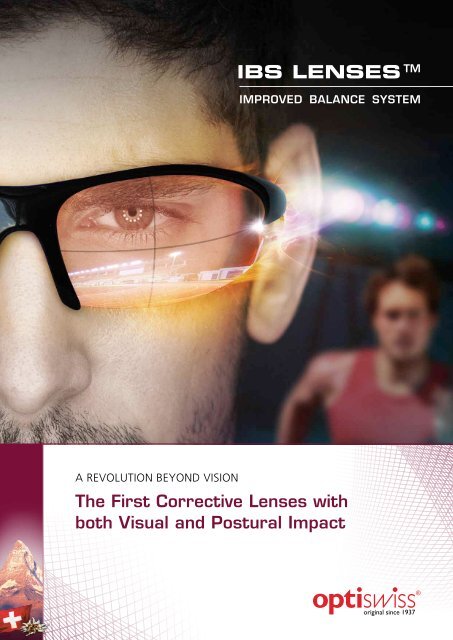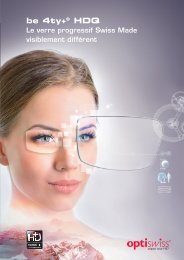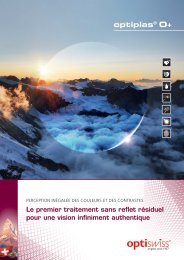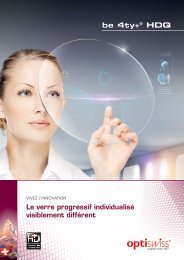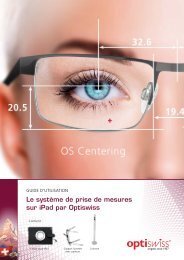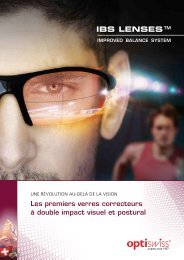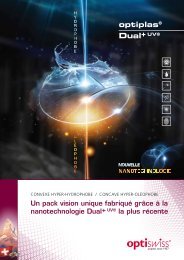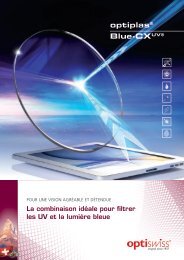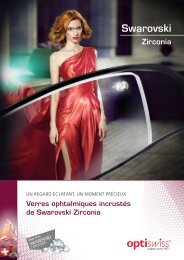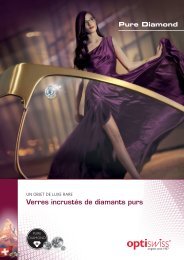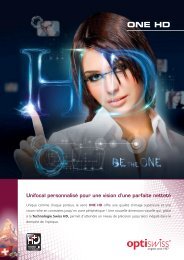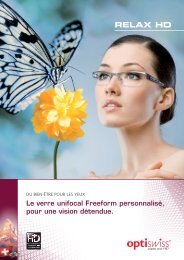IBS Lenses
Create successful ePaper yourself
Turn your PDF publications into a flip-book with our unique Google optimized e-Paper software.
<strong>IBS</strong> LENSES TM<br />
IMPROVED BALANCE SYSTEM<br />
A REVOLUTION BEYOND VISION<br />
The First Corrective <strong>Lenses</strong> with<br />
both Visual and Postural Impact
What Are <strong>IBS</strong> LENSES TM ?<br />
<strong>IBS</strong> LENSES TM are extremely innovative. Their defining feature is the black cross which is laserengraved<br />
on the inside of the product. A worldwide patent has been filed for this innovation.<br />
Made exclusively in base 8, these lenses are optically balanced and tailored to individual requirements. There<br />
are corrective and non-corrective, shaded and colorless versions.<br />
The dimensions and position of the engraved cross inside each lens, right and left, follow precise rules:<br />
• The dimensions of the two horizontal and vertical axes of the cross are almost equal with respect to the<br />
height of the lens.<br />
• The thickness of the axes has been scientifically defined.<br />
• The cross is precisely off-centered, based on the position of the pupil in the glasses.<br />
The effect of verticalization on vision<br />
The innovative nature of <strong>IBS</strong> LENSES TM lies in their impact on posture and vision. Wearing <strong>IBS</strong> LENSES TM<br />
immediately optimizes the individual‘s verticality, thus improving their postural balance and increasing the<br />
stability of their binocular vision. The results when stationary, standing or seated, or when in movement, are:<br />
• A balanced and comfortable posture, thanks to the spinal support.<br />
• More comfortable, higher performance vision which leads in particular to improved anticipation of<br />
pathways when moving, and consequently easier identification of the ideal trajectory.
Behind the Innovation: François Merz<br />
In 1999 François Merz, an equestrian coach from Neuchâtel, invented a system of gaiters to help horses find<br />
their balance. After this first discovery, in 2004, the reaction of one of the horses led him to understand its<br />
three-dimensional analysis system. Based on this, he invented the binocular vision system which he patented<br />
in 2006. He built an initial prototype himself that he tested with athletes from different disciplines, always<br />
getting the same successful results.<br />
In 2011 in Geneva, François Merz met Eugène Duvillard, an optometrist and member of the American<br />
Academy of Optometry. After watching the films and analyzing François Merz‘s experiences, Eugène Duvillard<br />
provided scientific explanations and helped develop new applications for the system. Using his contacts in<br />
the industrial sector, the technological solutions needed for making optical <strong>IBS</strong> LENSES TM were put into<br />
practice.<br />
How Does It Work?<br />
From the eye to the spinal column<br />
It was noted that the cross engraved in the lens acts as a marker for the gaze and helps to increase its stability:<br />
when looking into the distance, the eyes “rely“ on this visual marker. The cross therefore naturally leads to a more<br />
balanced, symmetrical, and “recentered“ positioning of the gaze between left and right.<br />
The image of the cross that the retina sees is transmitted to the brain through the central nervous system and<br />
communicates a new point of reference to it which is then transmitted to the spine. This triggers the „straightening<br />
up“ phenomenon observed in wearers and the simultaneous improvement of their sensory capacity.
Why Does It Work?<br />
The innovation is based on the existing relationship between the visual and vestibular systems, and more precisely<br />
on the visual capacity to directly affect the vestibular and therefore postural balance.<br />
Physiological reasons<br />
What is the vestibular system?<br />
• As the basis of our sense of balance, the vestibular system is the main sensory system which perceives<br />
movement in three dimensions and provides orientation in relation to the vertical. Located in the inner ear, it<br />
is composed in particular of the vestibular nerve which activates four nuclei. As the actual centers of sensorymotor<br />
integration for the movements that the body makes, these nuclei feed into the spine. The visual system<br />
is connected to the vestibular system through these nuclei.<br />
Anvil<br />
Stirrup<br />
Hammer<br />
Temporal bone<br />
Semicircular<br />
canals<br />
Vestibular<br />
nerve<br />
Cochlear<br />
nerve<br />
Level 4<br />
(C4)<br />
RIGHT<br />
Level 1<br />
(C1)<br />
Lateral vestibular nucleus<br />
Vestibular nerve<br />
Ciliated cells in<br />
semicircular canals<br />
+ utricle + saccule<br />
Lateral vestibulospinal tract<br />
(LVST)<br />
Semicircular<br />
canal<br />
LEFT<br />
Eardrum<br />
Cervical<br />
vertebra<br />
Thoracic<br />
vertebra<br />
1. Origin cells - Lateral vestibular nucleus<br />
2. The path is straight and passes through<br />
the entire length of the spinal cord.<br />
Located in the ventral funiculus.<br />
3. The vestibular system can influence the<br />
ipsilateral proximal muscles.<br />
Outer ear<br />
Auditory<br />
canal<br />
Vesicles<br />
(saccule + utricle)<br />
Cochlea<br />
Lumbar<br />
vertebra<br />
Straight in the<br />
ventral funiculus<br />
Middle ear<br />
Eustachian tube<br />
Diagram of the inner ear<br />
Vestibular system, vestibular nuclei, and innervation of<br />
inferior and superior limbs<br />
• The vestibular system is also linked to the receptors and sensors of the proprioceptive system, which<br />
perceives itself by perceiving the position of the limbs and the muscle tone, allowing muscular contraction<br />
(based on externally received information). These receptors and sensors are located in the skin and muscles.
Links between the vestibular system, visual system, and proprioceptive system can be easily<br />
observed.<br />
Vestibular system and visual system<br />
• When you try to visually follow swirling images projected in a circle on a screen, the ocular movements<br />
that you make will trigger dizziness after twenty seconds. This shows that visual stimulation affects the<br />
vestibular system.<br />
• Another example: when we see the train next to us pull away, we often get the impression that it is our<br />
train which is moving. In this case, the visual system was prioritized over the vestibular system.<br />
Vestibular system and proprioceptive system<br />
• In the case of dizziness or loss of balance triggered by a loss of information from the vestibular system,<br />
the simple action of touching a horizontal or vertical surface with our fingers allows us to find our balance<br />
again. Like the visual system, the proprioceptive system can also affect the vestibular system.<br />
Head movement<br />
The head moves to the RIGHT<br />
The eyes move to the LEFT<br />
Cranial nerve VI<br />
(abducens)<br />
Cranial nerve III<br />
(oculomotor)<br />
Ampullae of the right<br />
horizontal semicircular canal<br />
Right<br />
semicircular canals<br />
Left nucleus<br />
of VI<br />
Right nerve<br />
of III<br />
FML<br />
Utricle<br />
Ciliated<br />
cell<br />
Head<br />
movement<br />
Vestibular ganglion<br />
Vestibular nucleus<br />
Vestibular section of VIII<br />
Relationship between the vestibular system and visual system<br />
Conclusion<br />
The vestibular system acts as a central pivot point for balance. Our physiology shows that acting on the visual<br />
system can have a direct effect on an individual‘s balance and verticality. This hypothesis is verified by recent<br />
studies confirming that the visual system has priority over the vestibular system, beyond the links between them.
Demonstration through Clinical Studies<br />
The visual is more important than we imagine...<br />
University of Illinois, Chicago, USA, 2011<br />
The level of visual acuity directly affects the functions of postural control<br />
A study carried out by the University of Chicago in 2011 on a sample of individuals with varying degrees<br />
of deficient visual acuity – from a simple visual defect to complete blindness – revealed that the changes in<br />
acuity induced by corrective lenses of different strengths altered the generation of substances for anticipating<br />
postural control and consequently affected the compensation substances enabling this control.<br />
St.Rose Dominican Hospital, Henderson, Nevada, USA, 2012<br />
The visual system is the dominant system in postural balance<br />
A study based on researching the dominant system in postural balance among a group of young people aged<br />
between 20 and 30 has demonstrated the preponderance of the visual system in relation to the vestibular and<br />
somatosensory systems. Effectively, the 20 to 30-year-olds prioritize the visual to maintain an optimal postural<br />
balance. Addressing the lack of knowledge about this balance, the study also examined the opportunity of<br />
a prevention system to limit the pronounced degradation with age.<br />
Dep. of Physical Medicine and Rehabilitation, Inonu University School of Medicine, Malatya, Turkey<br />
The increase in acuity after cataract surgery is shown by an increase in postural stability and mobility<br />
This study, carried out in Turkey on a group of patients aged between 57 and 84 who had undergone cataract<br />
operations, showed a clear correlation with the increase in acuity after surgery; patients showed an increase in<br />
speed and more regular pace when moving, and therefore improved mobility. In parallel to these observations,<br />
the index of anterior-posterior, medial-lateral, and global stability increased very significantly, confirming the<br />
favorable effect of increased acuity on postural stability.
Céline van Till<br />
Abraham Tadesse<br />
Reynald Angot<br />
Arnaud Psarofagis
Who Are <strong>IBS</strong> LENSES TM For?<br />
The fields of application identified at this stage mostly concern the world of sport and athletes. In general,<br />
<strong>IBS</strong> LENSES TM give them the opportunity to practice their sport with greater ease and comfort in order to<br />
optimize their performance.<br />
Horse-riding and riders<br />
Wearing <strong>IBS</strong> LENSES TM enables riders to benefit from a better balance in the saddle and a stabilized position<br />
between right and left, front and back. Riders no longer move around and they really seem to be at one with<br />
their horses. They also find it easier to direct their horses, naturally selecting the ideal trajectory. The principle<br />
is the same for carriage drivers. You can see the carriage horses driven by a wearer of these lenses moving<br />
in perfect synchronicity.<br />
• Céline van Till, wearing <strong>IBS</strong> LENSES TM , was the only disabled person to compete in the Concours de<br />
Corsinge in 2012. Despite her disability, she won the second round of the competition.<br />
• Reynald Angot, team world champion at the Equestrian Games in Jerez de la Frontera in 2002, has also<br />
successfully tested the <strong>IBS</strong> LENSES TM .<br />
Running, long-distance runners, and marathon runners<br />
Wearing these lenses provides long-distance runners with a sense of ease and well-being which means they<br />
can run more comfortably. Beyond this, several experiments have shown that over a given course, runners<br />
achieve a better time with glasses with <strong>IBS</strong> LENSES TM than without.<br />
• Using <strong>IBS</strong> LENSES TM lenses, Abraham Tadesse, a Swiss marathon runner of Eritrean origin achieved<br />
a competition time that was two minutes under his training time. He is aiming for victory in his next<br />
competition.<br />
Sailing, skippers<br />
Arnaud Psarofaghis, a Swiss skipper, has noted the following phenomena with <strong>IBS</strong> LENSES TM lenses:<br />
• Increased stability on board while the ship is moving<br />
• Reduced tiredness from the effort of navigating<br />
• Greater precision of movement in maneuvers and adjustments<br />
• Feeling of ease
<strong>IBS</strong> LENSES TM and Aesthetics<br />
Seen from the outside: Is the cross unsightly?<br />
Just like you see in some photos, the cross on the lens has a dynamic and technical appearance. A bluetoned<br />
mirroring effect is also applied to the outside of the lens, which happens to make the lenses look a<br />
bit more “trendy“.<br />
However, <strong>IBS</strong> LENSES TM are primarily intended for specific uses, where the wearer is mainly looking for visual<br />
and postural comfort, such as when they are practicing sports.<br />
The wearer‘s view: Is the cross disturbing?<br />
No. The visual and postural comfort that comes from wearing the lenses makes you forget the view of the<br />
cross almost instantly. You see the lines of the cross when you put on the glasses, but they don‘t bother you.<br />
Then you stop noticing them
What Are the Prospects?<br />
The applications of <strong>IBS</strong> LENSES TM in daily life will be considered in future.<br />
• People who walk a lot could benefit in terms of balance and reduced tiredness.<br />
• <strong>IBS</strong> LENSES TM are also effective against seasickness and travel sickness. Drivers could improve their safety<br />
at the wheel through an improved understanding of their trajectory on the road.<br />
• People who work at screens could see a reduction in visual and postural fatigue due to relief to their<br />
spinal column.<br />
• Further research is being carried out into the impact on health.<br />
www.ibs-lenses.com<br />
Films and animations<br />
A full, dynamic, and professional website!<br />
Further information on the <strong>IBS</strong> LENSES TM project<br />
Learn about everyone involved in the story of the lenses as well<br />
as the role of Optiswiss.<br />
All the athletes‘ stories<br />
Horse riders, marathon runners, racing drivers...<br />
Come and meet the sports professionals who have chosen<br />
<strong>IBS</strong> LENSES TM .
Features of the <strong>Lenses</strong><br />
Type of lenses Material Color Mirror effect Coating<br />
ONE SPORT HD <strong>IBS</strong> [Single-Vison]<br />
PRO SPORT HD <strong>IBS</strong> [progressive]<br />
POLY 159<br />
Depending on<br />
technical possibilities<br />
Flash Silver<br />
on front surface<br />
Optiplas ® SSO<br />
on back surface<br />
Stamps<br />
ONE SPORT HD <strong>IBS</strong><br />
PRO SPORT HD <strong>IBS</strong><br />
59<br />
<strong>IBS</strong> TM<br />
SHD<br />
59<br />
<strong>IBS</strong> TM<br />
7.0<br />
4.0<br />
20 SHD<br />
2.5<br />
10.0<br />
14<br />
15<br />
15<br />
20<br />
19<br />
19<br />
Engravings<br />
Temporal<br />
Nasal<br />
POLY 159<br />
ONE SPORT HD <strong>IBS</strong> [unifocal]<br />
<strong>IBS</strong> TM<br />
59<br />
SHD<br />
PRO SPORT HD <strong>IBS</strong> [progressif]<br />
<strong>IBS</strong> TM<br />
59<br />
20<br />
SHD<br />
Adjustment recommendations<br />
• <strong>Lenses</strong> are generally adjusted to the remote focus.<br />
• With natural head and body posture as well as in the zero vision direction, the centring crosses need<br />
to rest on the middle of the pupil.<br />
PRO SPORT HD <strong>IBS</strong><br />
• Please note that in different sports it can make sense to focus lenses consciously deeper.<br />
• Since in most sports long distance is more important than short distance, we recommend choosing<br />
the lowest possible addition.<br />
Optiswiss AG • Lyon-Strasse 26 • CH-4053 Basel<br />
P +41 (0)61 337 15 15 • F +41 (0)61 337 15 02<br />
info@optiswiss.ch • www.optiswiss.com


